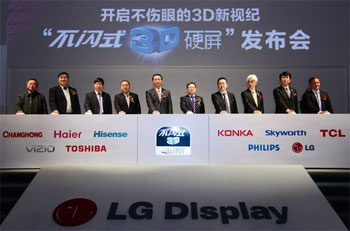The Advertising Standards Authority (ASA) – the independent regulator of media advertising in the United Kingdom – has this week ruled that LG Electronics can market its Cinema 3D TVs as “Full HD”, but only if the Korean manufacturer states clearly in its advertisements that the effect is achieved via passive 3D system. The adjudication came about following complaints made by cross-town rival Samsung and a technology journalist.
 |
| LG can market “passive” Cinema 3D TVs as full HD, ASA rules |
LG and Samsung Electronics have been embroiled in a bitter 3DTV format war ever since the former unveiled its FPR (film-type patterned retarder) passive 3D LCD technology which has proved popular among consumers primarily due to the affordability, comfort and convenience (no battery, charging nor synchronisation required) of the polarized 3D glasses. Meanwhile, Samsung has on numerous occasions championed the superior resolution delivered by its active-shutter extra-dimensional HDTV displays in 3D mode.
It’s hardly surprising then that Samsung submitted a complaint to the ASA to challenge the use of the terminologies “Full HD 3D Picture” and “Full HD 1080p” in LG’s promotional material for its passive 3D televisions (which is marketed under the moniker “Cinema 3D” in the UK).
In its defence, LG argued that even though its FPR passive 3D technology only delivers 540 lines of resolution to each eye, the simultaneous delivery of both odd and even lines within a single frame of image means that all 1080 lines of information will be perceived by the viewer’s brain. The company also provided third-party verification from an independent test lab, which supports LG’s claim that its Cinema 3D TVs are indeed “Full HD”.
After examining the evidence put forth by both parties, the ASA actually agreed with LG (for the most parts), judging that it was accurate to describe the Cinema 3D models as “Full HD” and “1080p”, as long as consumers are made fully aware that these 3DTVs use passive 3D technology. All LG Cinema 3D ads in its current form are to be pulled, with the phrase “passive 3D” to be made prominent in future marketing material.
Source: ASA

Well, in that case active 3D should be marketed as ‘double HD resolution’…
As a member of the industry – to be fair to LG – the D7000 / d8000 are the only models in the Samsung range to offer the full hd1080p 3d. It’s even been reported here that the lower models don’t have the processing power to achieve full hd 3d despite originally marketing it as that
Ok, a bit late but I have to disagree with JimmJanger. I have a rather old Samsung LE40C750 FULLHD, 1080p 3D TV and I con confidently tell you, it displays 1080p 3D in full yet this was one of the first ‘budget’ 1080p 3D TV’s to come on the market.
Both my Onkyo TX-NR818 AV reciever and the Samsung itself confirm it’s displaying 1080p/24hz cinematic. The only time it reduces 3D resolution is in most games which display in the lower HD format of 720p; still HD but not full.
The Passive LG’s on the other hand, halve the horizontal resolution of 1920 down to an ‘SD’ of 540 lines and this is clearly visibly reduced. With Active 3D you get full 1080p @ 1920 lines per eye, not 540 odd lines for one eye and the other 540 even lines for the other.
I don’t know how the ASA can accept LG’s claim, it’s clearly misleading and very definitely, not FullHD 3D, it’s not even HD anymore !!
The biggest problem with 3D TV’s is simply the size. You will never get the same experience you find in the cinema unless you view it on a decent size screen and even for a 65″ screen, you’d still need to sit rather closer.
For those that want to complain about flicker, consider that most LCD computer monitors run 60hz (same as 3D TV 120hz / 2) and that source of most TV broadcasts is 50/60hz, it’s only that modern TV’s upscale the source to 100hz or more (they claim).
Those that do suffer from flicker would also have problems with fluorescent strip lighting and similar and remember, standard movie format is 24hz, how did we ever manage to cope with that?
This passive vs active thing and talk of flicker is just the way one maker justifies their tech over another. TV’s and even cinema has always flickered, this is nothing new yet now it becomes a big issue with regards to 3D TV. What’s changed?
Owner of (Old) LE40C750 active shutter, 3D TV who doesn’t suffer flicker, just the rather high cost of glasses ;-)